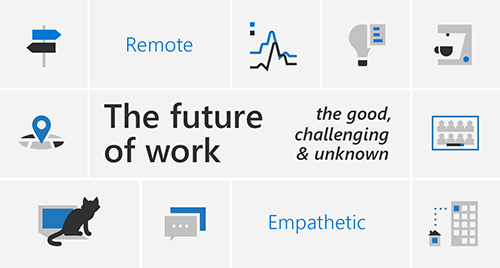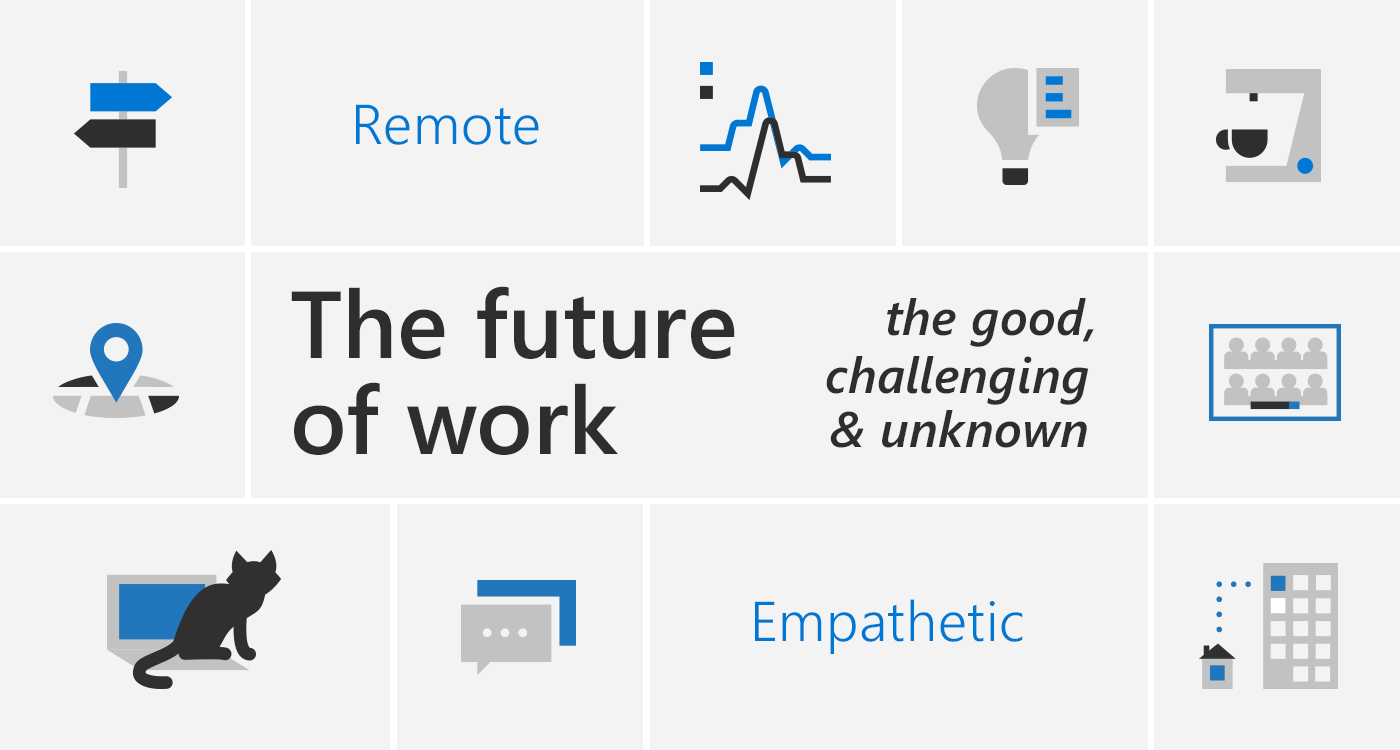
In the last four months, work has changed drastically. But will these changes persist into the future? Our second Work Trend Index report explores this idea by combining insights from three sources: trends behind how our customers use our tools; findings from a Harris Poll survey of over 2,000 remote workers in six countries1; and conclusions from over 30 research projects from across Microsoft that seek to understand the experience for remote workers today via surveys, interviews, diary studies, focus groups, and studies of the human brain.
Our goal for this research is to uncover both good and challenging aspects of remote work so we can accelerate product development in the right areas, anticipate how work will change in the future, and help our customers thrive in this new world of work.
The population reflected in the data consisted of information workers at small, medium and large enterprises and is not inclusive of the entire workforce. Read on for our key findings
Brainwaves reveal remote meeting fatigue is real
A commonly discussed pain point of remote work is that it can feel more challenging or tiring than in-person collaboration. Researchers from our Human Factors Labs recently set out to understand this phenomenon. Do remote work and video meetings actually tax our brain more than in-person work? The brain science suggests, yes.
Remote collaboration is more difficult, but the transition back to in-person work might be just as hard
In our Human Factors Labs, where we study how humans interact with technology, scientists ran an experiment to understand how the brain responds to collaborating remotely through computer screens compared to in person. This study began pre-COVID as part of ongoing work in Microsoft around the remote work experience. They asked 13 teams of two to complete similar tasks together – once in-person and once remotely. Research subjects wore an EEG device that monitored changes in brainwaves. The study found that remote collaboration is more mentally challenging than in-person collaboration. Specifically, brainwave patterns associated with stress and overwork were much higher when collaborating remotely than in-person. But they found something unexpected as well: If the pair first worked together remotely, their brainwaves suggested it was more difficult for them to work together in-person afterwards. It seems that the social connection and work strategies created when working in-person transfers to a remote setting, but the opposite is untrue. This study provided two important learnings. In a world that’s moving to more remote work, people find remote collaboration more mentally challenging. But also, as people return to more frequent in-person work as the pandemic eases it may feel more difficult than it did before COVID-19.
Video meetings lead to fatigue
A second study found that brainwave markers associated with overwork and stress are significantly higher in video meetings than non-meeting work like writing emails. Further, due to high levels of sustained concentration fatigue begins to set in 30-40 minutes into a meeting. Looking at days filled with video meetings, stress begins to set in at about two hours into the day. The research suggests several factors lead to this sense of meeting fatigue: having to focus continuously on the screen to extract relevant information and stay engaged; reduced non-verbal cues that help you read the room or know whose turn it is to talk; and screen sharing with very little view of the people you are interacting with.
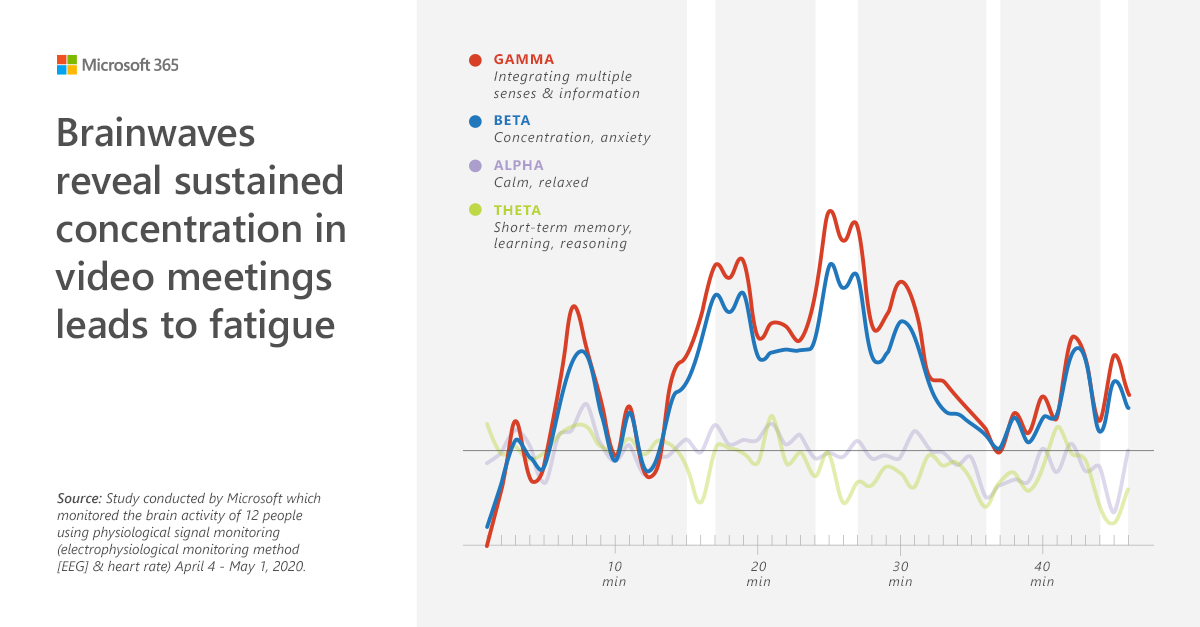
To help with this, we recommend taking regular breaks every two hours to let your brain re-charge, limiting meetings to 30 minutes, or punctuating long meetings with small breaks when possible.
To help address these challenges through our technology, today we also released a series of updates to Teams designed to help create more human connection with people you’re working with and to reduce meeting fatigue—two of which are Together mode and Dynamic view.
Together mode is a new option in the Teams meeting experience that uses AI segmentation technology to digitally place participants in a shared background. The view makes it feel like you’re sitting in the same room, which reduces background distractions, makes it easier to pick up on non-verbal cues, and makes back and forth conversation feel more natural. The view is great for things like brainstorms and roundtable discussions where multiple people are speaking. Early research2 using biosensors that measure brain activity show that the brain exerts less effort when participating in a meeting using Together mode when compared to the grid view. This suggests Together mode may help with the feeling of meeting fatigue some remote workers are experiencing.
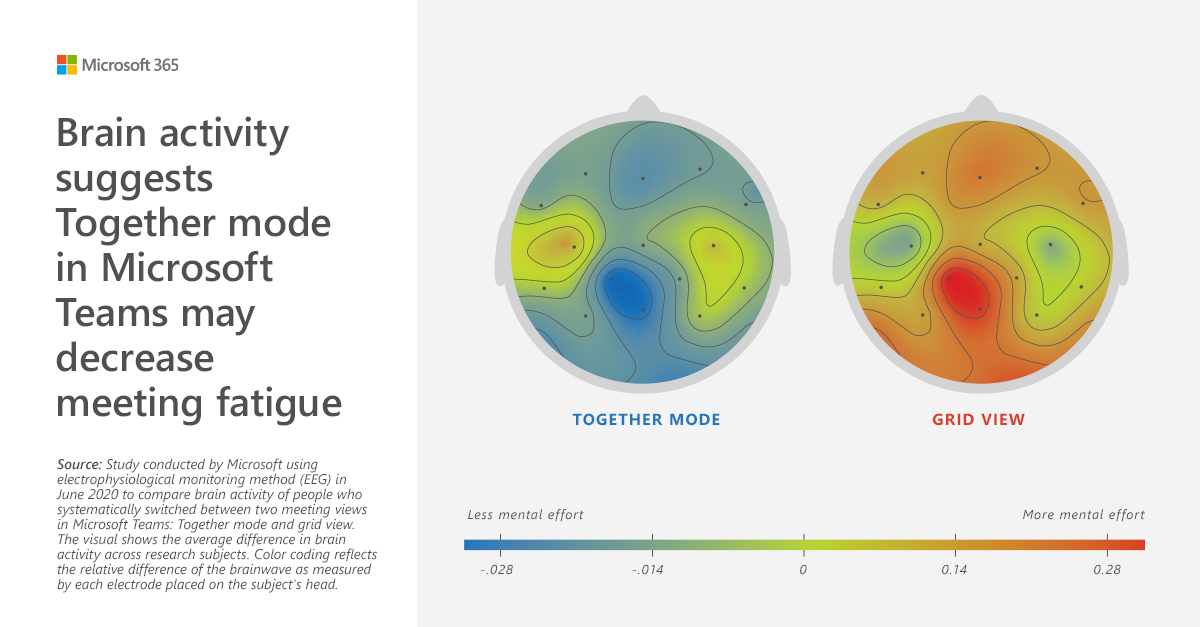
Dynamic view—We’ve also made a set of enhancements to the traditional Teams meeting view to make meetings more engaging. Using AI, meetings will now dynamically optimize shared content and video participants. New controls also let you personalize the view to suit your preferences and needs, such as the ability to show shared content and specific participants side-by-side, or to minimize shared content to see more of the audience you are presenting to.
Other Findings
The pandemic will have a lasting impact on work.
The 9 to 5 workday may be fading away.
Physical offices will not disappear in the future of work.
The pandemic will have a lasting impact on work
Across all our research, one of the most consistent themes was that this unique circumstance has accelerated the blending of work and life – which could soften dynamics of the workplace forever.
Over half of the parents we surveyed (54%) said it’s been difficult balancing household demands while working from home. This burden was felt most heavily by millennials as well as new entrants to the workforce, Generation Z. This may be because this group is more likely tasked with caring for younger children or sharing workspaces with roommates while managing a full-time job.
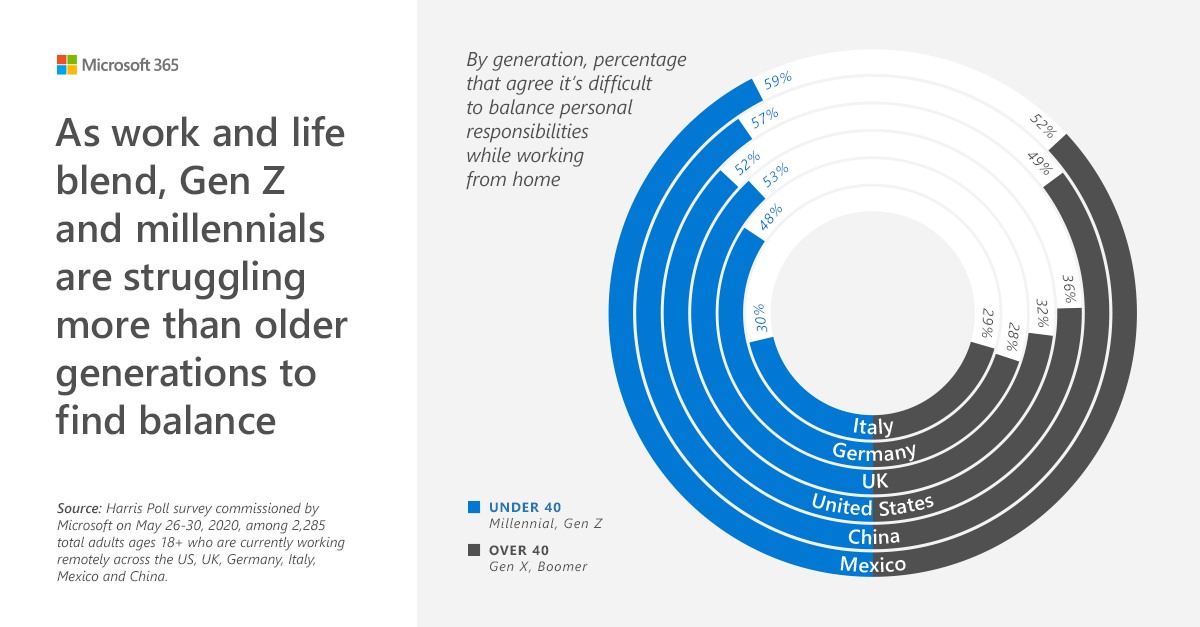
“With four people in the house right now, it makes finding our own space difficult.” – Information Worker
While balancing childcare with remote work may be temporary, it may change how we feel about our co-workers long-term. 62% of people we surveyed said they feel more empathetic toward their colleagues now that they have a better view of life at home. This feeling was especially pronounced in China and Mexico where 91% and 65% of those surveyed felt more empathetic, respectively.
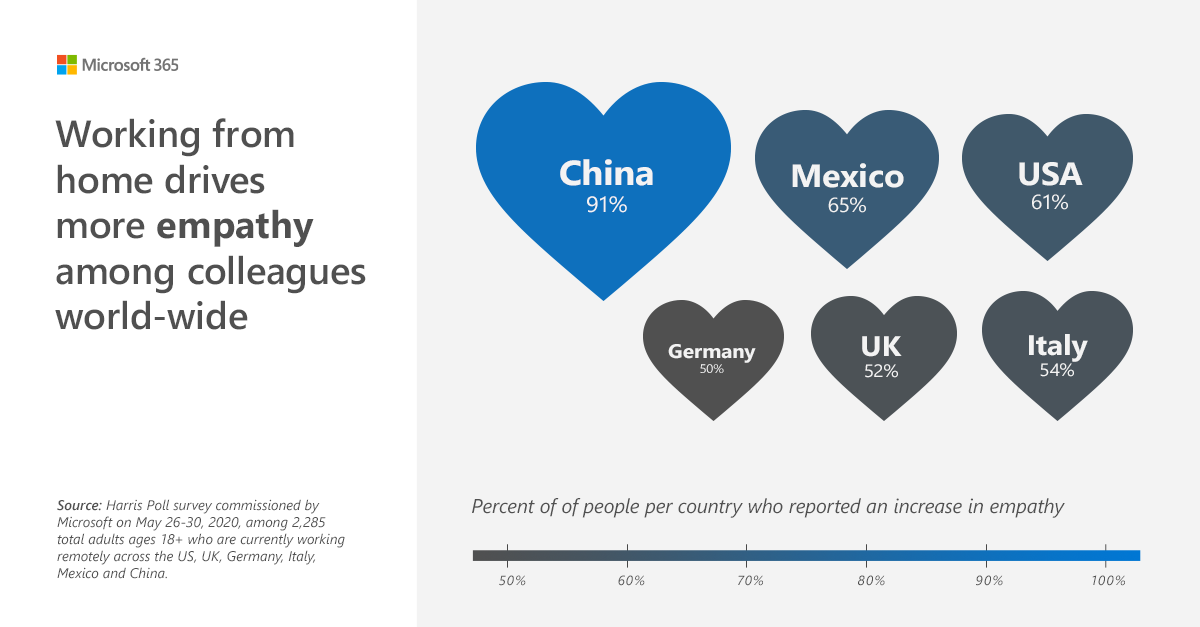
“We have accepted the work from home lifestyle. At my firm, they said you can carve out time during the day to deal with the kids and log on later. I feel a sense of relief that they understand the impact it has, having your kids at home.” – Information Worker
In some cases, the move to more remote work is also making work more inclusive. Over half (52%) of the people we surveyed feel more valued or included as a remote contributor in meetings because everyone is now in the same virtual room. This feeling was more strongly held by people in China (65%) and Germany (57%). We’ve also seen that in-meeting chat has become a channel for more people to share their perspectives. Specifically, chat messages within Teams meetings have increased over 10x from March 1 to June 1.
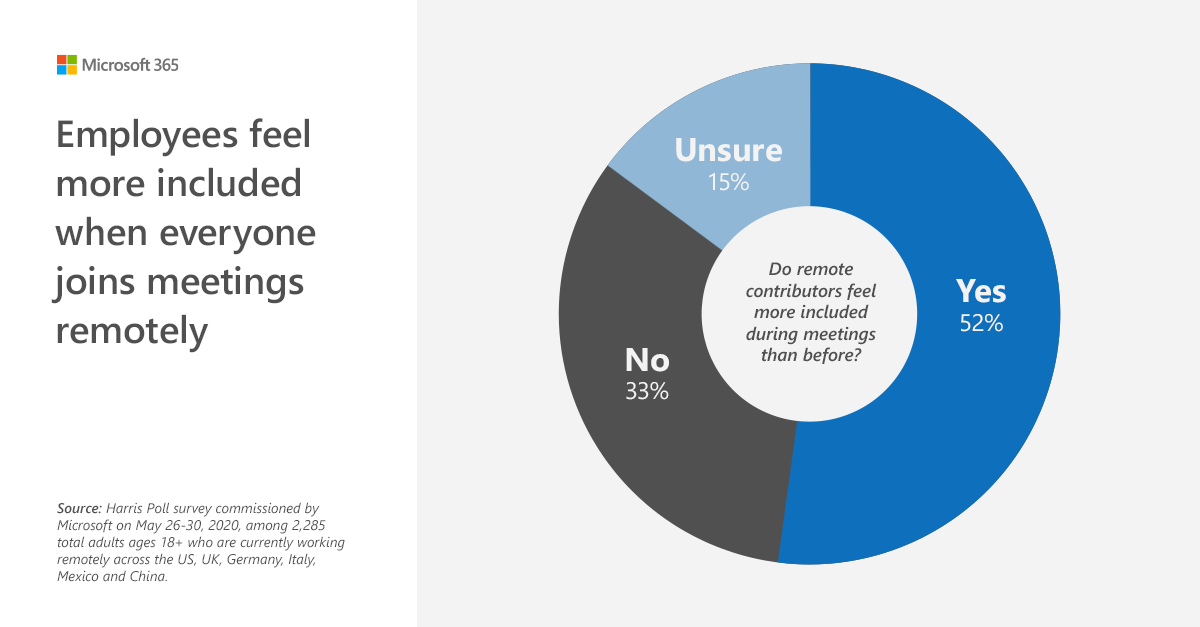
“Now that everyone’s on Teams, we’re all on equal footing.” – Information Worker
“Remote participants used to be invisible, but not anymore! – Information Worker
The 9 to 5 workday may be fading away
In our last report, we saw from March 1-31, the average time between our customer’s first and last use of Teams had increased by over one hour. In this report, we explore this concept further – is the 9 to 5, five-day workweek still disappearing? The data suggests, yes. In Teams, people are working more frequently in the morning and evening hours, but also on the weekends. Teams chats outside of the typical workday, from 8-9 a.m. and 6-8 p.m., have increased more than any other time during the day – between 15% and 23%. Weekend work is spiking as well – Teams chats on and Saturday and Sunday have increased over 200%.
“If we have a more flexible work schedule, we can be more productive. I can take breaks and not feel one bit bad about it.” – Information Worker
“My hours are getting longer… It’s a very real point, we’ve been connected prior, but now our laptops are sitting with us in the kitchen, and people need quick updates.” – Information Worker
To help our customers better manage their time in this new environment, we have features in Teams such as a focus status that lets your team know you need to set aside time on your calendar for focused work. You can also set quiet hours and quiet days to silence notifications in Teams when you’d like. In the coming weeks, we will be releasing the Reflect messaging extension in Teams, which gives managers an easy way to check-in with their team on topics like work-life balance. The suggested, customizable check-in questions span various topics and are designed to gauge the emotional wellbeing of the team. Responses can be public to the team or anonymous.
We see this blending of work and life as a durable workplace trend with potential for technology to help ease some of the challenges that come with it. You’ll see us continuing to innovate in the areas of organizational analytics and employee wellbeing in the near future.
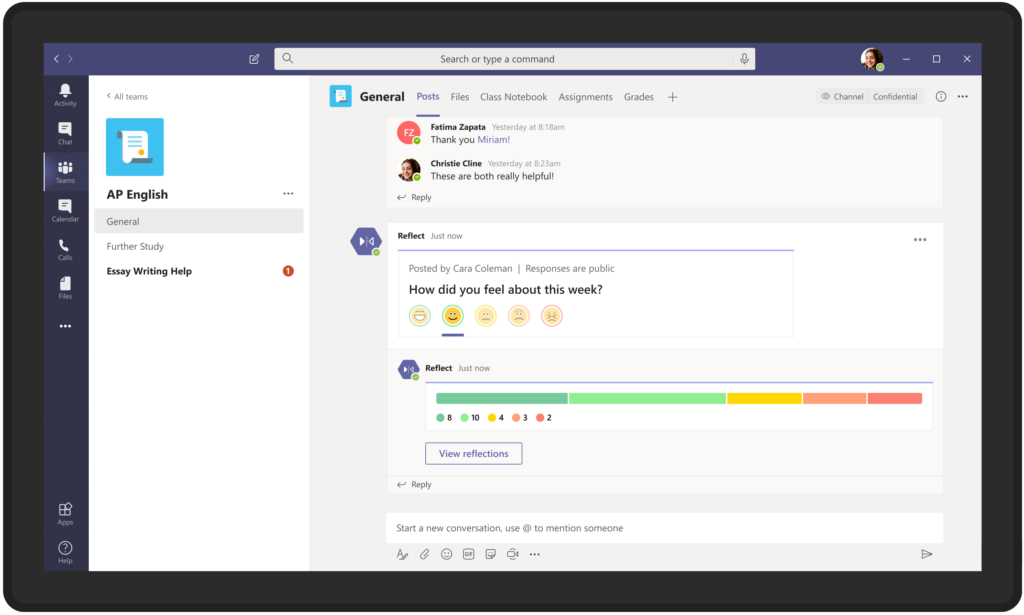
Physical offices will not disappear in the future of work
Many workers around the world have spent the last four months working remotely at least part-time. As teams have adjusted to this new reality, many are wondering – will physical offices disappear in the future of work? Our research indicates that work will likely be a fluid mix of in-person and remote collaboration.
For instance, 82% of managers surveyed expect to have more flexible work from home policies post-pandemic. More broadly, 71% of the employees and managers reported a desire to continue working from home at least part-time. We heard similar sentiments in our focus groups as well.
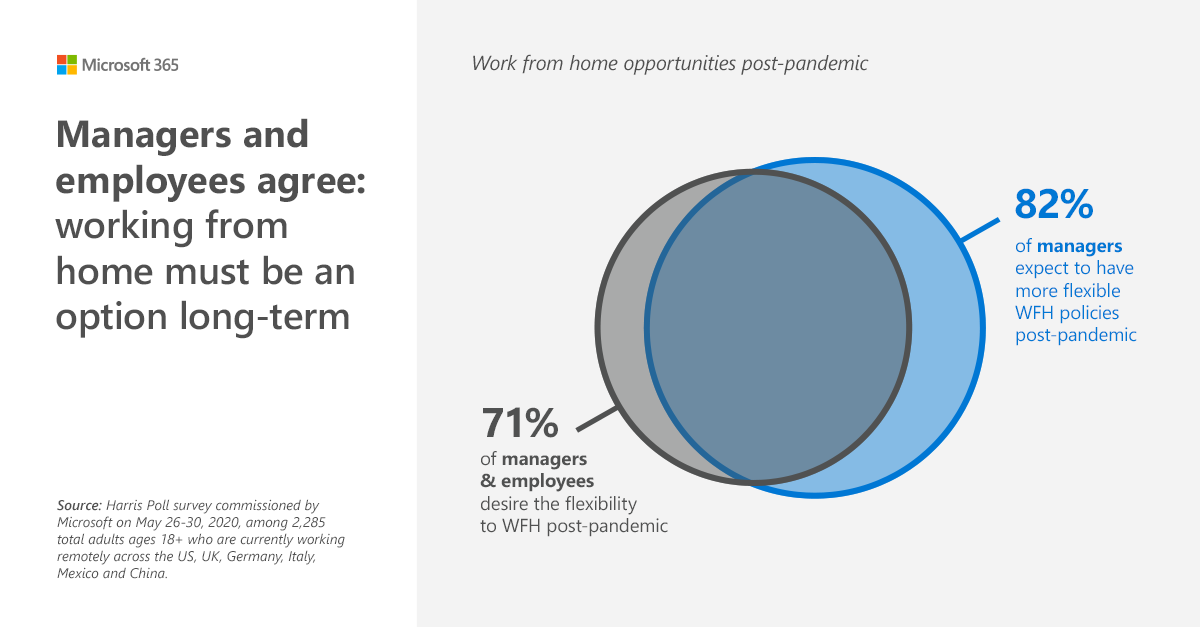
“If your boss couldn’t see you in the old days, that meant you weren’t working… As long as you can get things done, it really shouldn’t matter where you are.” – Business Decision Maker
Still, our research uncovered several pain points associated with working from home. Nearly 60% of people we surveyed feel less connected to their colleagues since working remotely more often. In China, this number spiked to 70%.
In addition, only 35% of respondents in one study3 have a dedicated home office. And only 5% of the people we surveyed in our Harris Poll live alone. So it’s no surprise that distractions, connection issues, and lack of ergonomic work environments were noted throughout our research as some of the top pain points of remote work. This indicates that while the future of work will be more remote than it’s ever been before, the physical office space – which brings benefits like connected, ergonomic workspaces and opportunities for social connecting and team bonding – will likely remain a core part of the future of work.
“When working from home, I’m sitting at the dining room table. At the office, I could have a keyboard and two screens and a comfortable chair.” – Information Worker
“There’s definitely been some issues because there are multiple people remotely working here, and we’ve had some Wi-Fi issues.”- Information Worker
Closing
In all, this global shift to remote work has created both opportunities and challenges for the future of our workforces. On the positive side, the unique circumstance of working and learning from home as a family has created more empathy between teammates and shifted perceptions held by both managers and employees that work can be done remotely. It’s also made work more inclusive for remote collaborators.
On the challenging side, more remote work can lead to elongated working hours, meeting fatigue, and missed in-person connections like spontaneous hallway conversations that can bond a team and make collaboration feel easier. And the lack of connected and comfortable home workspaces remains a productivity challenge for most of us.
At Microsoft, we have a unique opportunity to help our customers make the most of the opportunities while also addressing its challenges. We hope you’ll find that as the world of work has evolved, so too have our tools—and that, as we all navigate the accelerated change of an unprecedented time, we’re holding true to our mission to help every individual and every organization on the planet achieve more.
Microsoft takes privacy seriously. We remove all personal data and organization-identifying data, such as company name, from the data before using it to produce reports. We never use customer content such as information within an email, chat, document, or meeting to produce reports. Our goal is to discover and share broad workplace trends from aggregated data from the Microsoft Graph.
[1] Harris Poll Survey commissioned by Microsoft on May 26-30, 2020 among 2,285 total adults ages 18+ who are currently working remotely across the US, UK, Germany, Italy, Mexico, and China.
[2] Study conducted by Microsoft using physiological signal monitoring (EEG) in June 2020 to compare brain activity of people who systematically switched between two meeting views in Microsoft Teams: Together mode and grid view. The visual shows the average brain activity across research subjects. Color coding reflects the overall amount of energy omitted from different brainwaves.
[3] An ongoing study conducted by Microsoft found that during the screening process 35.3% of full-time information workers (N=570) work remotely in a dedicated home office.

